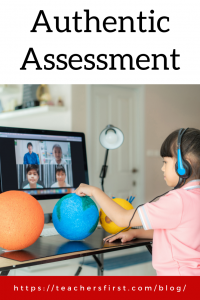As the father of six children, I spend much of my time in the car driving to their dance and soccer practices. Recently, my daughters completed dance team and soccer tryouts. During dance tryouts, the kids demonstrated their skills to the instructors and learned a routine to showcase their dance abilities. At soccer tryouts, my daughter completed skill stations for the coaches and played practice games. It would have been weird if my kids showed up to demonstrate their skills and been handed a sharpened number two pencil for multiple-choice assessments. While this strategy may seem like the obvious choice for athletics, we can do the same style of assessments for academic subjects in our classrooms.
Assessment is an essential component of teaching and learning. Traditional assessments provide a conventional way to measure student learning through tests and quizzes. They are easy to analyze, but they often lack real-world context. If my kids were assessed for their athletic skills using traditional assessments, they might have aced the questions, but could they back up their knowledge through their performance? Authentic assessments are creative learning opportunities that allow students to demonstrate their understanding of the learning objectives through relevant, real-world tasks. Using a mixture of traditional and authentic assessments in the classroom will provide students many opportunities to apply their knowledge. The perfect authentic assessment assesses the students’ learning while teaching them and improving their knowledge of the content.
Listed below are examples of authentic assessments you can use in the classroom. There is no specific length of time attached to an authentic assessment learning opportunity.
Student Portfolios
Portfolios are focused collections of student work to show progress over time. Portfolios are a great measure of students’ growth throughout a unit of study. Our archived Twitter chat archive The Essentials of ePortfolios and our OK2Ask webinar archive 3 Cool Tools for Digital Portfolios provide numerous portfolio tools and integration ideas. Wakelet (reviewed here) is an excellent tool for students to create portfolios to show what they know.
Digital Storytelling
This powerful authentic assessment practice engages students in the writing process and combines students’ writing with audio, images, and video to demonstrate their knowledge of the content. In our Twitter chat Digital Storytelling Strategies and Resources and our OK2Ask workshop on Digital Storytelling, we discussed a variety of tools and integration ideas. We also wrote a Tech Tool of the Month post on Story Maker, another digital storytelling tool, and a blog post on Adobe Spark Video that outlines ideas for integrating this tool with digital storytelling experiences.
Presentations
Presentations are a popular authentic assessment activity, but author Sharon Hall elevates them to new heights in her post, Take Your Presentations to the Next Level! Change up the point of view of the presentations to first person by having students pretend they’re a historical figure in a wax museum. If, for example, your students are presenting their findings on the biomes of the world, you could add persuasive writing to the project with a biome election where students are running against all the other biomes for the position of president. Why is their biome the best? Now the presentation is both informative and persuasive, adding more fun to the experience.
Assessment Tools for Mathematics
Mathematics Performance Task Bank (reviewed here) is a repository that provides performance-based tasks that serve as authentic assessment opportunities in mathematics. Passive test-taking and rote memorization are often the go-to for mathematics assessments. Short investigations and open-ended response questions engage the students in authentic assessment experiences.
By rethinking your assessment practices, you can provide hands-on, minds-on experiences for students that emphasize the connections between learning and the real world. Student-centered experiences will provide students the opportunity not only to show what they know, but to continue to grow and learn throughout the process. How are you using authentic assessments in your classroom? We’d love to hear your ideas and strategies in the comments below!


